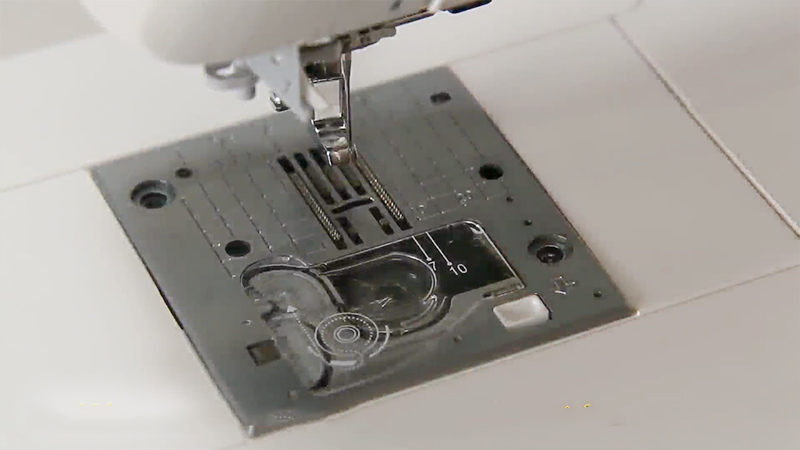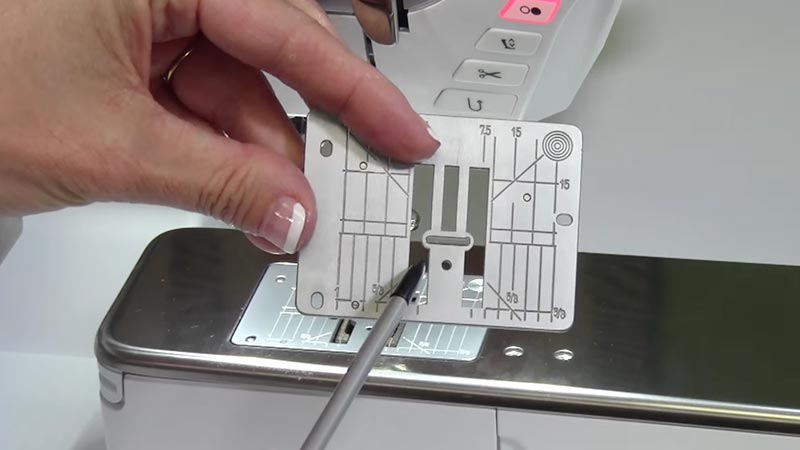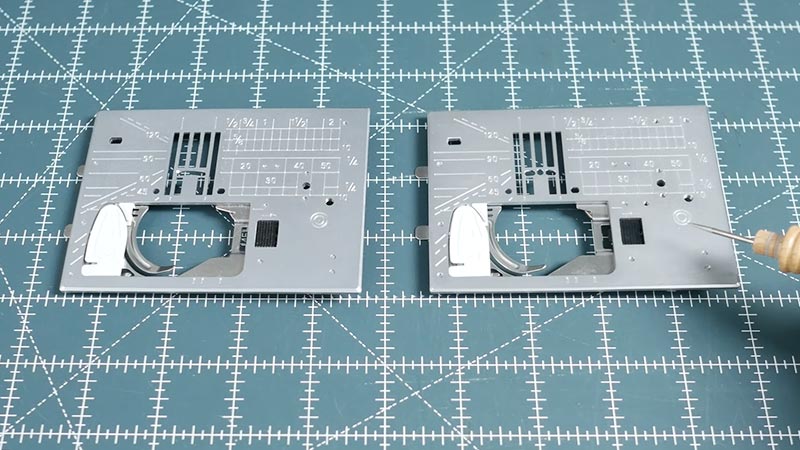In the intricate world of sewing, understanding the fundamental components of a sewing machine is essential for creating beautifully crafted garments and projects.
One such indispensable element is the throat plate, a small yet crucial piece of the sewing machine’s anatomy.
The throat plate, also known as a needle plate or stitch plate, plays a pivotal role in guiding the sewing machine’s needle, facilitating precise stitches, and maintaining consistent seam allowances.
As a gateway to the machine’s intricate mechanics, the throat plate ensures that fabric flows smoothly, enhancing the quality and precision of every stitch.
To grasp the art of sewing, one must first comprehend the significance of this unassuming but indispensable device.

What Does Throat Plate Mean In Sewing?
In sewing, a throat plate, also known as a needle plate or stitch plate, is a metal or plastic plate situated beneath the needle and presser foot of a sewing machine. It features an opening through which the needle passes, guiding its movement for precise stitching.
The throat plate typically has markings for seam allowances and accommodates various needle positions, allowing for different stitches and versatile sewing. It also provides access for the machine’s feed dogs to grip and move the fabric evenly.
Regular cleaning and maintenance of the throat plate are essential to prevent lint buildup and ensure smooth sewing operations, making it a vital component in achieving high-quality sewing outcomes.
What Functions Does a Throat Plate Serve in Sewing?
A throat plate in sewing serves several essential functions that are pivotal to the precision and quality of your sewing projects.
Here are the primary functions a throat plate fulfills in sewing:
Needle Guidance
The throat plate features an opening through which the sewing machine needle passes. It guides the needle’s movement, ensuring it accurately pierces the fabric at the designated location. This function is critical for creating even and consistent stitches.
Stitch Formation
Many throat plates are equipped with markings, grooves, or guidelines. These markings serve as reference points for sewers, assisting in maintaining uniform seam allowances and stitch alignment. They are instrumental in achieving professional-looking seams and hems.
Support for Feed Dogs
The throat plate provides access for the feed dogs, which are toothed mechanisms beneath the fabric. These feed dogs grip the fabric and move it forward or backward, ensuring even and consistent fabric feeding. Without the throat plate’s support, fabric bunching, puckering, and misalignment can occur during sewing.
Needle Positioning
Sewing machines often allow for various needle positions, and the throat plate accommodates these options. This versatility is essential for different sewing techniques, as it enables sewers to experiment with various stitch styles and techniques.
Thread Cutter
Some throat plates come with a built-in thread cutter, making it convenient to trim excess thread after completing a seam. This feature adds to the efficiency and ease of sewing.
Maintenance and Access
Throat plates are designed to be removable, facilitating the cleaning and maintenance of the sewing machine. Over time, lint, dust, and debris can accumulate beneath the throat plate, potentially impeding the machine’s performance.
Regular cleaning and maintenance help prevent sewing issues and ensure the machine operates smoothly.
What Are the Different Types of Throat Plates in Sewing?

In sewing, there are several types of throat plates or needle plates available, each designed to serve specific purposes or accommodate different sewing techniques. The choice of throat plate can significantly impact the outcome of your sewing projects.
Here are some of the different types of throat plates commonly used in sewing:
Standard Throat Plate
This is the default throat plate that comes with most sewing machines. It typically features a single round hole through which the needle passes. It’s suitable for basic straight stitches and general sewing tasks.
Straight Stitch Throat Plate
This throat plate is specifically designed for straight-stitch sewing. It has a single, narrow hole that helps prevent fabric from shifting sideways. It’s excellent for achieving precise straight stitches and seam allowances.
Zigzag Throat Plate
As the name suggests, this throat plate is intended for zigzag stitches and other decorative stitches. It has a wider, elongated slot to accommodate the side-to-side movement of the needle when creating zigzag patterns.
Quilting Throat Plate
A quilting throat plate is designed for quilting and free-motion sewing. It features a circular hole or no hole at all. This allows for better control of fabric movement during free-motion quilting, darning, or embroidery.
Single Hole Throat Plate
This throat plate has a single, small hole through which the needle passes. It is often used for precise topstitching and other applications where a very small hole is required to prevent the fabric from shifting.
Multiple Needle Position Throat Plate
Some sewing machines come with throat plates that allow you to change the position of the needle hole. This versatility is useful for creating decorative stitches or adjusting seam allowances.
Darning and Embroidery Throat Plate
These plates are designed for free-motion darning and embroidery. They may have no hole or a very small one to provide greater control over the fabric’s movement.
Serger or Overlock Throat Plate
Serger machines have their own specialized throat plates that are designed to accommodate multiple needles and loopers for creating overlock and serged seams. These plates are different from standard sewing machine throat plates.
Specialty Plates
Depending on the sewing machine model and brand, you may find specialty throat plates designed for unique purposes, such as creating buttonholes, inserting zippers, or sewing specific decorative stitches.
How Do You Choose the Right Throat Plate for Your Sewing Project?

Selecting the right throat plate for your sewing project is essential to ensure the success and precision of your stitching.
Here’s a step-by-step guide on how to make the correct choice:
Know Your Sewing Machine
Start by consulting your sewing machine’s manual to understand its compatibility with different throat plates. Not all machines are designed to accommodate various types, so it’s vital to work within your machine’s capabilities.
Determine Your Sewing Technique
Consider the specific sewing technique you’ll use for your project. Different throat plates are designed for distinct purposes. For straight stitches, opt for a straight stitch throat plate with a single, narrow hole.
If you plan to use zigzag or decorative stitches, choose a throat plate with a wider slot to allow for lateral needle movement.
Specialized Plates for Unique Projects
If your project is specialized, such as quilting, free-motion embroidery, or darning, look for a dedicated throat plate tailored to that purpose. Specialized plates offer greater control and precision in these specific applications.
Seam Allowances and Markings
Consider the desired seam allowance for your project. Some throat plates have seam allowance markings that help you maintain consistent seam widths. Select a throat plate with the appropriate markings if precise seam allowances are crucial.
Needle Position
If your sewing machine allows for multiple needle positions, choose a throat plate that corresponds to the needle position needed for your project. This is especially important when using decorative stitches or topstitching.
Review Project Guidelines
Thoroughly review your project’s pattern or instructions. In some cases, the pattern may recommend a specific throat plate for optimal results. Adhering to these guidelines can help ensure your project turns out as intended.
Test and Experiment
If you’re unsure which throat plate to use, conduct tests on fabric scraps or sample pieces. Experiment with different plates to determine which one produces the best results for your project and fabric type. This hands-on approach can provide valuable insights.
Consider Fabric Type
Different fabrics may require different throat plates. Delicate, lightweight fabrics may benefit from a throat plate with a smaller hole to prevent puckering, while heavy fabrics might need a larger opening for smoother needle passage.
Your fabric choice should guide your throat plate selection.
Seek Expert Advice
Don’t hesitate to seek guidance from experienced sewers or engage with sewing communities and forums. Fellow sewers often have valuable insights and recommendations based on their experiences with similar projects.
Prioritize Safety
Always prioritize safety when selecting a throat plate. Ensure that the throat plate you choose aligns with your sewing machine’s safety features and guidelines, guaranteeing a secure and hazard-free sewing experience.
FAQs
Can I modify a throat plate to create custom stitch widths or seam allowances?
It’s not advisable to modify a throat plate, as this may damage the plate and affect your sewing machine’s functionality. Instead, choose a compatible throat plate that suits your specific needs.
Do throat plates come with specific maintenance instructions from the manufacturer?
Yes, throat plates often come with maintenance guidelines provided by the manufacturer. These instructions may include recommended cleaning intervals and lubrication details to keep your sewing machine running smoothly.
Are there any safety precautions associated with throat plates in sewing machines?
Safety precautions include turning off the sewing machine before removing or cleaning the throat plate and handling the plate with care to avoid injury or damage.
What should I do if my throat plate is difficult to remove for cleaning or maintenance?
If your throat plate is challenging to remove, refer to your sewing machine’s manual for instructions on proper removal. Avoid using excessive force, which may damage the plate or machine.
Is it necessary to adjust the tension settings when changing throat plates for different sewing techniques?
When changing throat plates, it’s advisable to review and adjust your machine’s tension settings as needed. Different plates may affect the thread tension and stitch quality, so making necessary adjustments can ensure optimal results.
To Recap
The throat plate’s role in sewing is as unassuming as it is indispensable. It may seem like a small, inconspicuous component, but it is the linchpin that ensures the precision, consistency, and quality of every stitch.
The throat plate guides the sewing machine’s needle, maintains proper seam allowances, and supports even fabric feeding, making it a critical element in the art of sewing.
Whether you’re a novice or an experienced seamstress, understanding the significance of the throat plate is the first step toward mastering the craft.
By appreciating its essential function, you unlock the potential to create beautifully crafted garments and projects that showcase your skill and artistry.
Leave a Reply